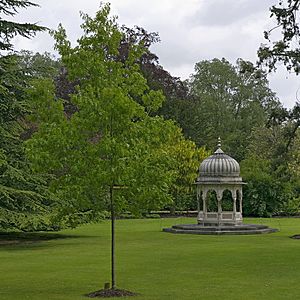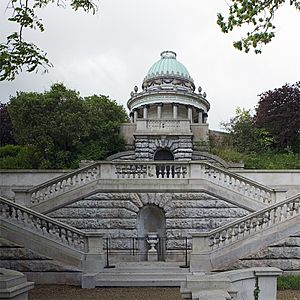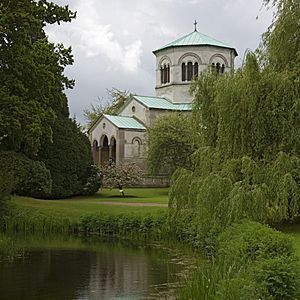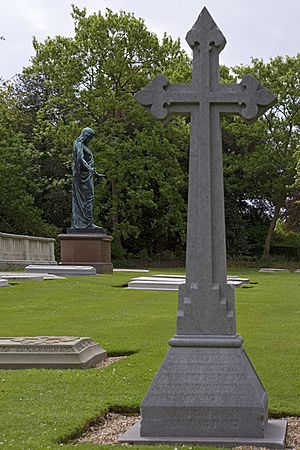Frogmore facts for kids
The Frogmore Estate or Gardens comprise 33 acres (130,000 m2) of private gardens within the Home Park, adjoining Windsor Castle, in the English county of Berkshire. It is the location of Frogmore House, a royal retreat, and Frogmore Cottage. The name derives from the preponderance of frogs which have always lived in this low-lying and marshy area near the River Thames. This area is part of the local flood plain.
It is also the site of burial places for the British Royal Family: the Royal Mausoleum containing the tomb of Queen Victoria and Prince Albert; the Duchess of Kent's Mausoleum, the burial place of Queen Victoria's mother; and the Royal Burial Ground. The gardens are Grade I listed on the Register of Historic Parks and Gardens.
Contents
Frogmore House
Frogmore House was built in the 1680s and the lease was purchased by Queen Charlotte in 1792. She employed the architect James Wyatt to remodel and expand Frogmore House for her.
In 1900 Prince Louis of Battenberg was born there.
On the estate near the House is Frogmore Cottage, built for Queen Charlotte around 1801.
Places of burial
Duchess of Kent's Mausoleum
The first of two mausoleums within the Frogmore Gardens is the burial place of Queen Victoria's mother, Victoria of Saxe-Coburg-Saalfeld, the Duchess of Kent. The Mausoleum was designed by the architect A J Humbert, to a concept design by Prince Albert's favourite artist, Professor Ludwig Gruner.
In the latter years of her life, the Duchess lived in Frogmore House and in the 1850s, construction began on a beautiful domed 'temple' in the grounds of the estate. The top portion of the finished building was intended to serve as a summer-house for the Duchess during her lifetime, while the lower level was destined as her final resting place. The Duchess died at Frogmore House on 16 March 1861 before the summer-house was completed so the upper chamber became part of the mausoleum and now contains a statue of the Duchess by William Theed (1864).
Royal Mausoleum (or 'Frogmore Mausoleum')
The second mausoleum in the grounds of Frogmore, just a short distance from the Duchess of Kent's Mausoleum, is the much larger Royal Mausoleum, the burial place of Queen Victoria and her consort, Prince Albert.
Queen Victoria and her husband had long intended to construct a special resting place for them both, instead of the two of them being buried in one of the traditional resting places of British Royalty, such as Westminster Abbey or St. George's Chapel, Windsor. The mausoleum for the Queen's mother was being constructed at Frogmore in 1861 when Prince Albert died in December of the same year. Within a few days of his death, proposals for the mausoleum were being drawn up by the same designers involved in the Duchess of Kent's Mausoleum: Professor Gruner and A. J. Humbert.
Work commenced in March 1862. The dome was made by October and the building was consecrated in December 1862, although the decoration was not finished until August 1871.
The building is in the form of a Greek cross. The exterior was inspired by Italian Romanesque buildings, the walls are of granite and Portland stone and the roof is covered with Australian copper. The interior decoration is in the style of Albert's favourite painter, Raphael, an example of Victoriana at its most opulent. The interior walls are predominantly in Portuguese red marble, a gift from King Luis I of Portugal, a cousin of both Victoria and Albert, and are inlaid with other marbles from around the World.
The monumental tomb itself was designed by Baron Carlo Marochetti. It features recumbent marble effigies of the Queen and Prince Albert. The sarcophagus was made from a single piece of flawless grey Aberdeen granite. The Queen's effigy was made at the same time, but was not put in the mausoleum until after her funeral.
Only Victoria and Albert are interred there, but the mausoleum contains other memorials. Among those is a monument to Princess Alice, Grand Duchess of Hesse-Darmstadt (1843–1878), Victoria's second daughter, who died of diphtheria shortly after her youngest daughter May (1874–1878). In the centre of the chapel is a monument to Edward, Duke of Kent, Victoria's father. He died in 1820 and is buried in St George's Chapel, Windsor.
One of the sculptures is of Queen Victoria and Prince Albert in Saxon Dress, commissioned after Prince Albert's death and executed by William Theed (1804–91). It was unveiled on 20 May 1867 in Windsor Castle, and was moved to the Royal Mausoleum in 1938. The plaster model, which was exhibited in 1868 at the Royal Academy of Arts, is on loan from the Royal Collection to the National Portrait Gallery, London. The official guidebook includes an image of the sculpture (but not of the pedestal), and mentions that the Queen recorded in her diary that the idea for it came from Victoria, Princess Royal (her eldest child) and that the inscription on the plinth is a quotation from The Deserted Village by Oliver Goldsmith. The inscription on the plinth alludes to the poet's lament for the passing of the imagined village of 'Sweet Auburn'.
The building has been closed to the public since 2007 because it is structurally unsound. The foundations are waterlogged, and the lower elements of the building are disintegrating. In February 2018, the Royal Household announced it was undertaking repair work on the mausoleum; the work is expected to be complete by 2023. Work commenced in June 2018, with a deep trench dug out around the building to create a dry moat to allow the stonework to dry out. With the long dry summer that occurred in 2018, this will have benefitted that process. The leaking roof, drainpipes, and windows will also be repaired and replaced before the internal restoration begins.
Royal Burial Ground
Since its inauguration in 1928, most members of the royal family, except for Kings and Queens, have been interred in the Royal Burial Ground, a cemetery behind Queen Victoria's mausoleum.
Among those buried there are Prince Arthur, Duke of Connaught, and Prince Henry, Duke of Gloucester, as well as Prince George, Duke of Kent; the Duke of Windsor, who reigned as King Edward VIII before abdication; and his wife Wallis. Many members of the families of Prince Christian of Schleswig-Holstein and of the Marquess of Cambridge are also buried there.
Also in the Burial Ground is the cenotaph of Queen Maria of Yugoslavia, a great-granddaughter of Queen Victoria and wife of King Aleksandar I of Yugoslavia. Having lived in exile in London, she was buried here from 1961 until April 2013, when her remains were exhumed and returned to Oplenac, Serbia.
Other garden features
Also within the grounds lie various garden buildings and monuments, including the 'Gothic Ruin' (1793), 'Queen Victoria's Tea House' (a brick pavilion building of 1869).

To the south east of Frogmore Cottage is an Indian kiosk, made of marble, taken from the Qaisar Bagh of Lucknow by the Viceroy of India, Charles Canning, 1st Earl Canning in 1858. The kiosk is octagonal with an onion dome with round arches and deep eaves. The kiosk is Grade II listed.
Public access
The house and gardens are usually open to the public on about six days each year, usually around Easter and the August Bank Holiday. The Royal Burial Ground may be viewed from around its perimeter on the days that the gardens are open to the public. The Duchess of Kent's mausoleum may also be viewed externally, but is never open to the public.
Images for kids
-
The Gothic Ruin by James Wyatt
See also
 In Spanish: Frogmore para niños
In Spanish: Frogmore para niños









